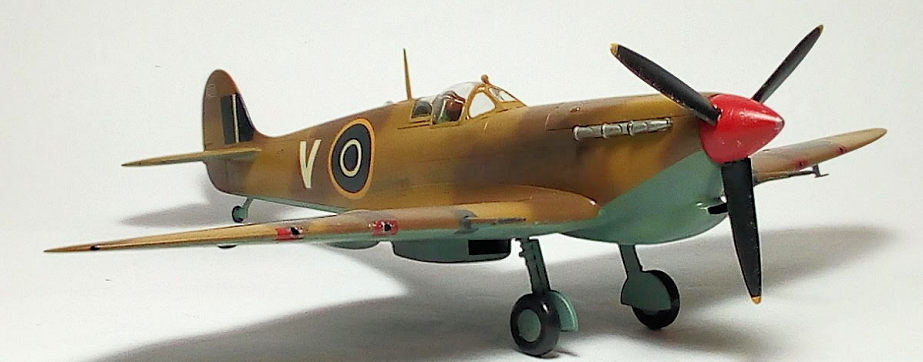
Tamiya 1/48 Spitfire Vb
| KIT #: | 61035 |
| PRICE: | €15 |
| DECALS: | Three options |
| REVIEWER: | Spiros Pendedekas |
| NOTES: |

| HISTORY |
Extensively used not
only by the RAF, but also by other Allied countries before, during, and after
World War II and produced in greater numbers than any other British aircraft,
the excellent Spitfire needs no introduction. It was the only British fighter
produced continuously throughout the war with many variants, using several wing
configurations and two main types of engines. In 2021, the Spitfire continues to
be popular among enthusiasts, with nearly 60 remaining airworthy and many more
are static exhibits in aviation museums throughout the world.
Royal Hellenic Air Force (EBA) received the first Supermarine Spitfire Mk.Vb/c’s
from the RAF at the end of 1943 in the Middle East, equipping the 335 and 336
Squadrons. After extensive action in North Africa and Yugoslavia, those
Spitfires returned to Greece in October 1944, where they participated in the
first phases of the Civil War. They were systematically replaced by newer edi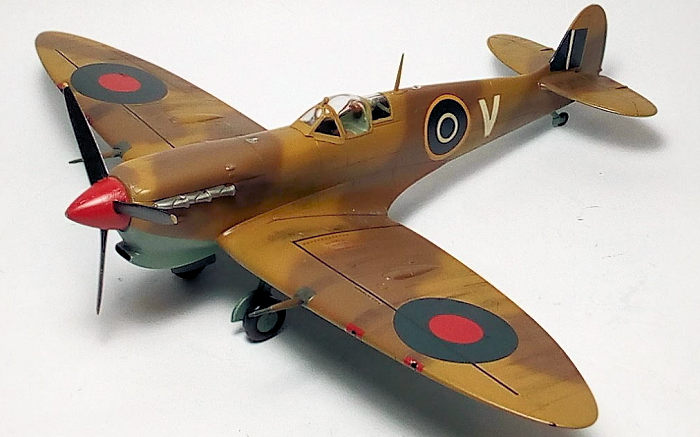 tions
and, from 1947 and onwards, were used for operational training at the Air Force
Academy.
tions
and, from 1947 and onwards, were used for operational training at the Air Force
Academy.
Most EBA Mk.Vb/c’s bore (at least in Africa) the bulky Vokes filter. Some
featured the typical elliptical wings, while others wore the "cut" ones, with
evidence not very clear upon the type of wingtips each plane carried.
Like RAF planes, they typically carried the "Middle East Camouflage" (Dark Earth
and Midstone over Azure Blue), with EBA personnel frequently adding customized
touches onto those planes. These included overpainting the red areas of the
fuselage and fin insignia with dark blue, painting prop hubs blue/white and
decorating the cockpit sidewalls, among, possibly others. Again, info, as well
as pic evidence, is not that plenty.
Seemingly, 335 Sq aircraft carried at the fuselage sides both the distinctive
letter of the aircraft and the two Squadron call letters, whereas 336 Sq planes
most probably carried only the characteristic letter of the aircraft.
The appearance of EBA Spitfires would change in September 1944, when
335 and 336 left Africa and relocated to Nuova of Italy. They then belonged to
the "Balkan Air Force" and flew missions over Yugoslavia, having received the
"Temperate land scheme camouflage" (Dark green and Ocean gray over Medium sea
gray). The cone of the propeller, as well as the aft fuselage band were painted
"Sky". It was with this appearance that they returned home by the end of the
war.
| THE KIT |
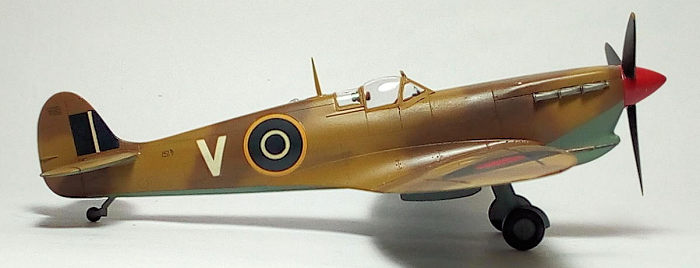 This is the
classic 1/48 Tamiya kit. Inasmuch as the Spitfire needs no intros, the same can
be said for this kit: it is beautiful, well-engineered and oozing of quality. It
comes in the usual attractive Tamiya box, with superbly molded light tan sprues,
crystal clear transparencies, nice decals and excellent instructions.
This is the
classic 1/48 Tamiya kit. Inasmuch as the Spitfire needs no intros, the same can
be said for this kit: it is beautiful, well-engineered and oozing of quality. It
comes in the usual attractive Tamiya box, with superbly molded light tan sprues,
crystal clear transparencies, nice decals and excellent instructions.
Initially appearing in 1994 (its Mk.I "sister" kit having appeared one year before), with its latest reissue in 2007, the only “complaints” seem to be the not up to modern standards cockpit detailing (though it is still very well detailed) and, most importantly, various shape issues (not dead serious, though), that have been addressed through the years. With the shape looking good to me, as well as cockpit detail looking sufficient (I almost always close my canopies anyway…), I saw no reason why I should not give this beauty of a kit a go!
| CONSTRUCTION |
I believe this must
have been one of the kits that contributed to the classic “Tamiya” quote (throw
glue and paint in the box, shake, open and, voilà: a nice model!). Everything
fell together effortlessly!
For the record: I assembled the 8-piece cockpit and then added the rear
bulkhead, oxygen bottles, radio, throttle and gear levers at their corresponding
fuselage inner locations. Basic cockpit color was Hu78 for the British interior
green, with instrument panel, levers, voltage regulator, stick grip, seat
headrest and cus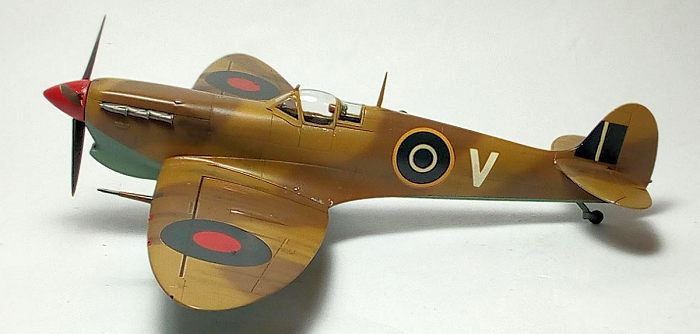 hions
black. The instrument panel was dry brushed with silver and had some red “knobs”
added with a 10/0 brush. The various raised cockpit details were dry brushed,
too and the seat received seat belts made from doped masking tape, their buckles
simulated with my fine tip silver pen.
hions
black. The instrument panel was dry brushed with silver and had some red “knobs”
added with a 10/0 brush. The various raised cockpit details were dry brushed,
too and the seat received seat belts made from doped masking tape, their buckles
simulated with my fine tip silver pen.
I proceeded by joining the two fuselage halves, throwing the assembled cockpit
from the undersides and attaching the lower one piece wing. The upper wing
halves followed, which were first attached to the fuselage root area. With the
locating pins removed, they were then allowed to “rest” onto the lower wing
mating surfaces, where they were joined by using the capillary action of very
thin glue. This way, seamless wing root joints were ensured (not that the
specific kit needed such help…). The cockpit “door” was attached at “closed”
position, as well.
I continued by adding the elliptical wingtips, the tail planes, the three piece
radiator, the two piece oil cooler and, of course, the three piece Vokes filter.
I did not attach the 90 gal slipper tank: it was not very often carried and,
personally, compromises the beautiful Vb Trop Spit looks. The radiator faces
were painted black and dry brushed with silver, the Vokes and oil filter bland
ends were just painted flat black, to provide an illusion of extra depth.
No filler was needed whatsoever and, after some light sanding, I blanked the
cockpit, radiator and filter openings and headed to the paint shop!
| COLORS & MARKINGS |
I first applied an
underside coat of Hu159, for the Azure Blue. All landing gear parts, wheel bays
and door innards received the same color, as well. After masking the undersides,
I freehanded the top camo by using Hu29 and Hu63 for the dark brown and tan
respectively. Upon removing the masks, I gave the model a coat of Future and
went on to apply the decals.
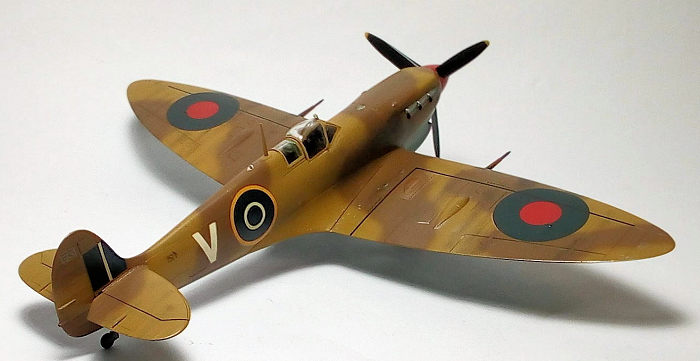 I used the
kit decals, which, though not the thinnest and not the quickest in detaching
from their backing paper, behaved very well: easy in application with good
adherence, sufficiently opaque and no sign of silvering whatsoever. A coat
Future sealed them.
I used the
kit decals, which, though not the thinnest and not the quickest in detaching
from their backing paper, behaved very well: easy in application with good
adherence, sufficiently opaque and no sign of silvering whatsoever. A coat
Future sealed them.
I then went on and hand painted the fuselage and fin insignia red areas with
Hu15 dark blue. The slightly different blue shade might have very well been
observed in reality, as the Greek Squadrons performed the overpainting job by
hand with whatever dark blue might have been available.
Since I could not locate that many pictorial records regarding the RHAF Vb’s in Africa, I decided to apply only a white “V” (it came from the decal sheet) at fuselage sides, without any serial number. This makes my chosen coding kind of a “generalized” assumption: “V” coded Greek Vb’s would almost surely have existed, but, most possibly, carrying serial numbers also. Oh well…
| CONSTRUCTION CONTINUES |
I attached all landing
gear parts including the wheels. Oleos were highlighted with my fine tip silver
pen, tires were painted black with the nicely molded “DUNLOP” logo dry-brushed
with light gray. The wing gun patches were carefully hand painted red.
The 5-piece nice prop was assembled, had its hub painted red (again, an
assumption), its blades painted black with yellow tips and affixed in position.
The equally nice exhausts were painted Testors Burned Metal with their ends
black, to simulate hollowness. They were then attached in place, together with
the antenna mast, fuel filler cap and pitot tube. Gun barrels and pitot tips
were painted Testors burned metal.
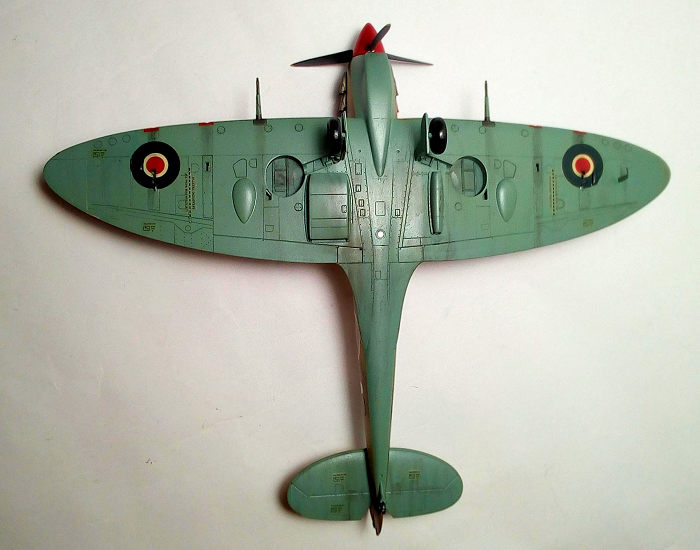 Due
to the harsh operating (and, literally, sandblasting) environment, some
weathering (with dry brushing, washes and dry pastels) was applied: apart from
the “usual” engine soot, it mainly included blades and wings leading edges
chipping, some sun fading and general dirtying especially undersides and
particularly at the wheels surrounding areas. A final matt coat sealed
everything and gave this “African” Spitfire its final hue.
Due
to the harsh operating (and, literally, sandblasting) environment, some
weathering (with dry brushing, washes and dry pastels) was applied: apart from
the “usual” engine soot, it mainly included blades and wings leading edges
chipping, some sun fading and general dirtying especially undersides and
particularly at the wheels surrounding areas. A final matt coat sealed
everything and gave this “African” Spitfire its final hue.
The one piece gunsight was a well molded transparent part that had its base
painted black and was installed atop the panel shade. I then hand painted the
transparencies (which sported nicely defined frames) and attached them (at
“closed” position – my usual preference for many reasons, laziness in over
detailing the cockpit included!). I could not resist and went on attaching the
top windshield external mirror, its glass part replicated with a blob from my
silver pen. The upper and lower ID lamps transparencies had their bases painted
silver and affixed in position with Clearfix.
I then called this bird done!
| CONCLUSIONS |
Back in the early 90s,
the modeling world was extremely happy to see Tamiya (and Hasegawa) issuing
quarter scale “modern” kits of the iconic Spitfire. The Tamiya kit featured
crisp molds, excellent, easy buildability, nice decals and instructions. Though
plagued by some shape faults (which are more important in the eyes of Spitfire
devotees), the finished model looked like a Mk.V (with the Hasegawa following a
tad aft, as it exhibited more serious shape issues and was lacking in fit).
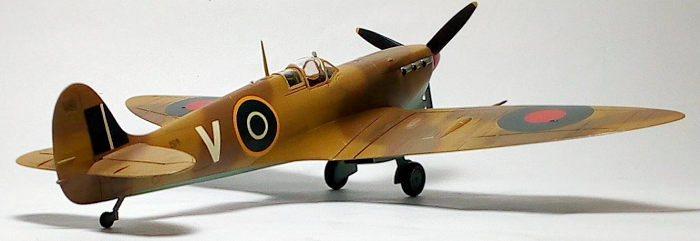 If you want a
modern Mk.V 1/48 Spitfire, you should look no further than the very good new
tool Airfix offering. As of 2022, Tamiya has not yet released a new tool Mk.V to
follow its 2018 superb Mk.I, though one would bet that such a release might not
be far away, especially taking into account that no reissue of its “classic”
1994 Vb kit has taken place.
If you want a
modern Mk.V 1/48 Spitfire, you should look no further than the very good new
tool Airfix offering. As of 2022, Tamiya has not yet released a new tool Mk.V to
follow its 2018 superb Mk.I, though one would bet that such a release might not
be far away, especially taking into account that no reissue of its “classic”
1994 Vb kit has taken place.
Truth be told, this now
“classic” Tamiya is an utterly enjoyable build, with excellent molding and fit.
Coupled with the amazing Tamiya engineering, it practically builds itself!
Instructions are top notch, decals are great, as well: this is an ideal kit for
a beginner who wishes to enter the 1/48 scale.
Totally respecting all “critiques” regarding shape, it can positively be stated
that the finished model looks nothing else than an Mk.Vb. If you happen to own
one, treat yourself with a build! You’ll be amazed with the ease of construction
and the gorgeous final looks.
Happy modeling!
7 March 2022
Copyright ModelingMadness.com. All rights reserved. No reproduction in
part or in whole without express permission. If you would like your product reviewed fairly and fairly quickly, please contact the editor
or see other details in the
Note to
Contributors. Back to the Main Page
Back to the Review
Index Page
Back to the Previews Index Page